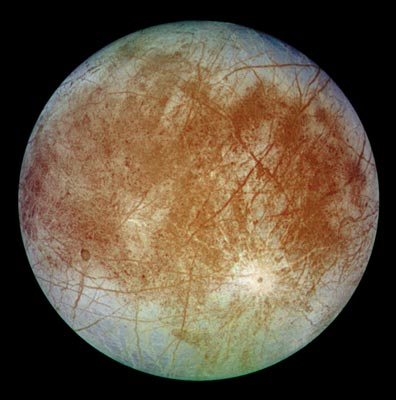Infecting Other Worlds
By Richard Greenberg
Should space explorers observe "planetary protections"?
Should space explorers observe "planetary protections"?

DOI: 10.1511/2001.28.296
When isolated ecological communities come into contact, the result can be opportunity or catastrophe, depending on one’s point of view. Some organisms find new places to colonize; others are destroyed. The changes are dramatic and can last forever.
Because extraterrestrial life may exist, planetary exploration could bring trouble if people are not careful enough. This danger was recognized decades ago, when astronauts ventured to the Moon. When the crews returned, they were quarantined to prevent "back contamination," the hazard that some infectious extraterrestrial germ might be riding with them. The safety procedures were largely symbolic: After all, who knew the incubation period for some hypothetical other-worldly microbe? Whether the hardware and samples returned needed sterilization was also largely a matter of speculation. Subsequent planetary exploration has not involved astronauts, nor have samples or hardware been returned, so back contamination has not been an issue. But forward contamination—that is, the infection of alien ecosystems by terrestrial organisms hitchhiking on a spacecraft—is a distinct possibility.
During the 1960s, considerations of forward contamination focused on Mars, the Moon being considered inhospitable to terrestrial microbes. It came as a great surprise when Apollo 12 astronauts retrieved, along with many rocks, the camera from a robotic probe sent to the Moon three years earlier, and subsequent investigation of that unit found bacteria inside that could still be cultured. With Jupiter’s moon Europa and its ice-covered ocean now a prime candidate in the search for extraterrestrial life, the possibility that similarly hardy microbial stowaways might be carried there creates concern.
By definition, forward contamination does not affect the Earth, so why care? To a large extent this question is one of ethics: Is it morally right to endanger life elsewhere? There are practical dimensions as well. One is the far-out possibility that we might antagonize potentially proactive enemies. That hazard seems remote, especially given that people have damaged so much life on Earth without having provoked conscious retaliation. A more plausible prospect is that a campaign of exploration would contaminate another planet before fully characterizing life there. If space probes destroyed or modified extraterrestrial life before finding out about it, they would fail to achieve one of the key goals of planetary exploration.
With just this concern in mind, the late Carl Sagan and Sidney Coleman derived in the early 1960s a quantitative requirement for the sterilization of spacecraft to be used in an anticipated program for the exploration of Mars. The probability that these missions would characterize Martian life before significantly contaminating that planet needed to be nearly 100 percent. Sagan and Coleman set, as an arbitrary value, the figure at 99.9 percent. That is, the chance of messing things up should be less than one in a thousand. Then, assuming conditions relevant to Mars and making educated guesses about the strategy that might be used to detect life, they showed how to compute the demands for sterilization. This work established the maximum acceptable probability of a single viable organism remaining aboard any vehicle intended for planetary landing: The number was 10–4, or 1 in 10,000.

Image from the Galileo probe courtesy of the Jet Propulsion Laboratory
That evaluation was adopted by the Committee on Space Research ("COSPAR") of the International Council of Scientific Unions in 1964, because in principle and according to treaty, establishment of standards and monitoring of compliance regarding planetary protection is an international effort. Although the result was given this impressive imprimatur, it had a rather shaky foundation. For one, it derived from a limited notion of what planetary protection is for (preventing destruction of alien life until after its study). It selected the level of acceptable risk arbitrarily. Also, it relied on a pre-Space Age understanding of the planet Mars and some rather crude assumptions about how well a terrestrial organism might survive the trip and colonize the new setting. Finally, the prescription was based on a 1964 guess about the nature of a future campaign for exploring the Red Planet.
Whether the COSPAR policy was ever appropriate for Mars is therefore highly questionable. And the prescription is certainly not appropriate for Europa, which has a completely different environment. How then should one go about setting proper criteria for planetary protection?
The basis for any evaluation must be a moral or philosophical principle. The one introduced by Sagan and Coleman could be applied to Europa with appropriate calculations. But their standard is self-serving, in that it does not address the well-being of life on another planet, except that it should survive long enough to satisfy human curiosity.

Paramount Pictures/The Everett Collection, Inc.
At the opposite extreme would be another principle—that preventing any interference with life on other planets should take absolute priority. We call this concept the "prime directive," borrowing this term from the television series Star Trek, which was contemporaneous with Sagan and Coleman's work and the COSPAR resolution. Actually, in Star Trek the prime directive usually applied only to protecting alien societies, and even then it was readily discarded as needed to advance the plot line. Yet the phrase seems appropriate here because it conveys a certain absolutism. The problem with this principle is that, if rigorously applied, it would likely bring exploration of some of the most interesting moons and planets to a halt.
Is there another moral principle that might provide a rational basis for developing a standard of planetary protection, one more objective than the principle of Sagan and Coleman and less constraining than the absolute isolationism of the prime directive? We recently proposed the following candidate principle, which is objective but not absolute. It is based on the idea that there is already a process of natural cross-contamination, something so far mostly quantified in the context of the terrestrial planets, which are thought to exchange chunks of crust from time to time after a large meteorite or comet hits and sends ejecta off into space at escape velocity. Living cells could conceivably survive such a journey: After all, many kinds of delicate organic molecules (including, perhaps, the very molecules that allowed life to develop here in the first place) are regularly carried to Earth within meteorites.
As long as the probability of people infecting other planets with terrestrial microbes is substantially smaller than the probability that such contamination happens naturally, exploration activities would, in our view, be doing no harm. We call this concept the natural contamination standard.
On one hand, the natural contamination standard for Europa may seem nearly as strict and confining as the prime directive, because the natural transport of viable organisms from Earth may be so difficult that it provides an impossibly stringent criterion. On the other hand, it may be equally difficult for organisms from southern California or Florida, where most planetary spacecraft are built and launched, to survive the voyage and proliferate in the cold, icy environments of Europa. One will not know until after careful scientific study.
We believe the natural contamination standard has considerable merit, but there may be other good candidates as well. The point is that before anyone can establish rules for the sterilization of planetary probes in a meaningful way, some fundamental principle, based on ethical and philosophical considerations, is needed.
Recognizing that Europa might be vulnerable to forward contamination, NASA recently commissioned a study by the National Research Council to evaluate standards of planetary protection for upcoming missions. At the heart of the resulting report, issued just last year, is a specific recommendation: “The probability of contaminating a europan ocean with a viable terrestrial organism at any time in the future should be less than 10–4 per mission.” The rationale given for this number was citation of the 1964 COSPAR resolution for Mars, a source that is neither appropriate nor relevant.
In fact, the proposed Europa standard is flawed for a completely different—and rather disturbing—reason. According to several members of the committee that prepared the report (including a statement by its chair), the recommended 10–4 value did not really come from the COSPAR resolution they cited; rather it was simply a compromise among the subjective judgments of the members of the group. The reference to COSPAR was added afterward to lend an appearance of objectivity.
Before NASA proceeds too much further with planning for its Europa campaign, the scientific community needs to reopen the discussion of proper guidelines for preventing forward contamination. The starting point might be Sagan and Coleman’s preserve-it-until-we-are-done-with-it, the prime directive, the natural contamination standard or some other principle that gains a consensus. Once such a principle is in place, quantitative standards for mission design, construction and operations can be developed using the kinds of scientific information assembled in the National Research Council report.
Another important reason for continuing discussion is that knowledge of Europa has increased tremendously—even since that report was issued—thanks to interpretation of data from the Galileo mission. There is now a considerable body of evidence that the icy crust has cracks and openings that may connect with the interior ocean. So the Europan biosphere, if it exists, may well extend to within centimeters of the surface. Any assessment of the probability of forward contamination should include the latest understanding of these conditions.
The new work makes Europa an even more inviting target for exploration, because its ice-covered ocean appears more likely to be able to support life, and organisms might be available for sampling more easily. Of course, Europa would also be even more vulnerable to forward contamination than most planetary astronomers had thought possible just a year or two ago. Recognizing the potential vulnerability, NASA should not continue with exploration of the Jovian system—indeed, the agency should probably not go too far even in planning—unless proper deliberations and calculations are included to ensure that humanity will do no inadvertent harm to any neighbors in space.
Click "American Scientist" to access home page
American Scientist Comments and Discussion
To discuss our articles or comment on them, please share them and tag American Scientist on social media platforms. Here are links to our profiles on Twitter, Facebook, and LinkedIn.
If we re-share your post, we will moderate comments/discussion following our comments policy.